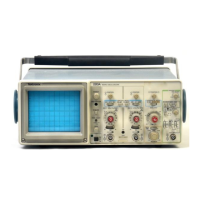General Information—2213A Operators
Table 1-1
Electrical Characteristics
Characteristics Performance Requirements
Supplemental Information
VERTICAL DEFLECTION SYSTEM
Deflection Factor
Range
2 mV per division to 5 V per division
in a 1-2-5 sequence.
5 mV per division to 5 V per division
gain is adjusted with VOLTS/DIV switch
set to 10 mV per division.
2 mV per division gain is adjusted
with VOLTS/DIV switch set to 2 mV
per division.
Accuracy
±3%
Range of VOLTS/DIV Variable Control Continuously variable between
settings. Increases deflection factor
by at least 2.5 to 1.
Step Response Rise Time
Rise time is calculated from the formula:
Rise Time
0.35
0°C to + 35°C
Bandwidth (—3 dB)
5 mV per Division to 5 V per
Division
5.8 ns or less.
0°C to 50°C
2 mV per Division to 5 V per
Division
7.0 ns or less.
Bandwidth (—3 dB)
0°C to +35°C
2 mV per Division
Dc to at least 50 MHz.
Measured with a vertically centered
6-division reference signal from a 50 Q
source driving a 50 (1 coaxial cable
that is terminated in 50 fl, both at
the input connector and at the probe
input, with the VOLTS/DIV Variable
control in the CAL detent.
5 mV per Division to 5 V per
Division
Dc to at least 60 MHz.
0°C to +50°C
2 mV per Division to 5 V per
Division
Dc to at least 50 MHz.
AC Coupled Lower Limit
10 Hz or less at - 3 dB.
Bandwidth Limiter
Upper limits ( - 3 dB) bandpass at
10 MHz ±15%.
Chop Mode Switching Rate
500 kHz ±30%.
Input Characteristics
Resistance
1 Mfl ±2%.
Capacitance
20 pF ±2 pF.
Maximum Safe Input Voltage 2 ^ ^
DC Coupled
400 V (dc + peak ac) or 800 V ac p-p
to 10 kHz or less.
See Figure 1 -1 for derating curve.
AC Coupled
400 V (dc + peak ac) or 800 V-ac p-p
to 10 kHz or less.
1-2
REV MAR 1984
K

